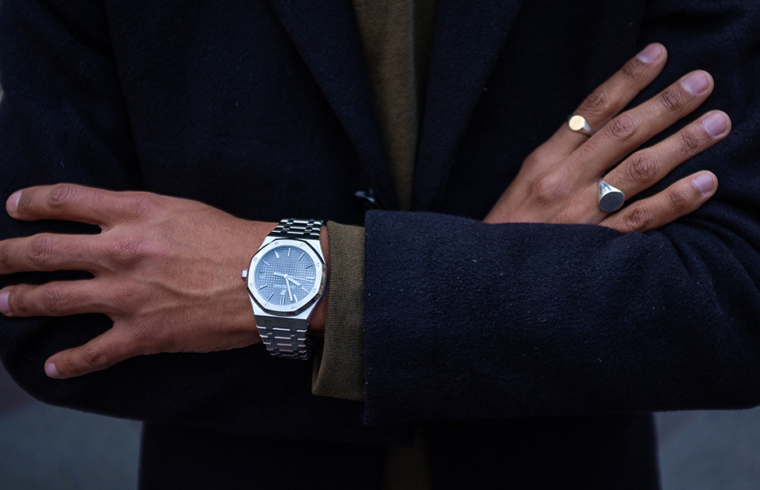The origin myth of the Audemars Piguet Royal Oak is as legendary as its design. It’s 1971, and the Swiss watch industry is feeling a little hot under the collar; the Japanese are flooding the market with cheap quartz watches and no one’s buying expensive automatics anymore.
Like many brands, Audemars Piguet was staring down the barrel of bankruptcy. It needed a hit and fast. Alighting on some feedback from the Italians, who had expressed some interest in a luxury steel watch, then managing-director Georges Golay picked up the phone, late afternoon on the day before the 1971 Baselworld was due to start and called watch designer Gerald Genta.
Would Genta be able to design a luxury sports watch, exquisitely finished, that might appeal to the Italians? And could it be on Golay’s desk by the morning?
Genta delivered. What he came up with was the Royal Oak, and the watch industry hasn’t been the same ever since. It was, and still is, the definitive sports watch, but with numerous models and variations released since it can all be slightly confusing, which is where we come in.
How The Audemars Piguet Royal Oak Came To Be
Inspired by a traditional diver’s helmet in all its riveted glory, the original watch had an octagonal bezel with eight visible screws and an unusual blue patterned dial. It was slim yet relatively large for a watch at the time – 39mm – and had a complex, integrated steel bracelet.
Powering it was the automatic Calibre 2121, a date version of the Calibre 2120, which was first introduced in 1967 and the result of a technical collaboration between Jaeger-LeCoultre and Audemars Piguet with money chipped in by Patek Philippe and Vacheron Constantin; all of whom were in the market for an ultra-slim movement to customise.

Given the nautical inspiration, Genta insisted the name have some sea-faring reference, so Audemars Piguet came up with Royal Oak – the moniker for a series of eight ships (a nod to the eight bezel screws) from the Royal Navy. A year later in 1972, it was ready for launch. It was more expensive than a gold Patek Philippe and 10 times more than a steel Rolex Submariner, rubbing plenty up the wrong way in the process.
The Audemars Piguet Royal Oak: Innovative But Controversial
The Royal Oak was far from a success and by the end of Basel Fair 1972 gleeful critics were predicting Audemars Piguet’s imminent bankruptcy. However, the unusual design won customers over, and soon AP was running adverts emphasising its exclusivity.
Fast forward 20 years, and the brand decided to shake things up again; it wanted to make it sportier, appealing more to a younger crowd. Enter the Offshore, designed by 22-year-old Emmanuel Gueit. It was huge – nicknamed “The Beast” during development – and offended purists with even Genta himself marching onto the Audemars Piguet booth at Basel shouting that his creation had been ruined; a move that didn’t harm its success.
Since then, very little has changed design-wise. Its instantly recognisable form has housed crazy complications and been made in everything from gold and platinum to alacrite 602, a superalloy used by the aeronautical industry. It’s been made smaller, larger, thinner; been frosted and skeletonised but essentially that sketch that Genta made one evening in 1971 has never been bested.
The Audemars Piguet Royal Oak Design
For something dreamt up in an evening, there’s a lot going on with the Royal Oak. First, there’s the unusual octagonal bezel with its eight screws, which aren’t actually screws but bolt-heads; the screws that do the work of connecting the bezel to the case are within the watch. Then there’s the famed integrated bracelet, entirely built by hand; a detail that probably accounts for the lack of an impromptu wrist epilation when wearing it.

The original Ref.5402, much prized by collectors, had the AP initials above the six rather than the 12, but other than that nothing has changed since 1971. Aesthetically it feels like a design out of time, it has none of the retro tool watch vibe inherent in many of the other watches around at the same time, and its future-tech sleekness still looks modern today.
It’s a watch like no other, which is why Audemars Piguet was able to successfully sue a brand called Swiss Legend for ripping it off back in 2014.
Audemars Piguet Royal Oak: The Best Modern Iterations
The Classic
This is the 2019 update of the classic three-hander with date window. It has a slightly wider 41mm case, and here the tapisserie pattern on the dial is grande rather than petit. The indices have been enlarged, and now there is just a date window at three, whereas previously the aperture was sharing dial space with an hour marker.
Powering it is the brand-new Calibre 4302, which Audemars Piguet has also put in the Code 11:59 and which has a 70-hour power reserve. You do have the option of a black or grey dial, but blue is obviously the connoisseur’s choice.
The Offshore
If you are going to buy an Audemars Piguet Royal Oak Offshore, there is no point in opting for something subtle. This is a big, bold, brash timepiece, so it makes sense to embrace those personality traits and use it as an excuse to have some fun.
Which brings us neatly to this amazing version in green with a camo rubber strap. Not everyone’s going to like it, and you likely can’t wear it to the office, but it’s an impressive piece of mechanical muscle. Deploy with caution.
The Chronograph
The in-between case size of 38mm was a sweet spot for a lot of brands this year and Audemars Piguet put it to good use in its chronograph collection.
There’s a 41mm version of this, containing the same integrated column-wheel chronograph movement, but there is something about losing that 3mm that turns the aesthetics from nice to “I need one on my wrist now”. The 4.30 date window is a little controversial for some, but having that small flaw to quibble about only adds to its perfection.
The Concept Watch
Concept watches rarely get turned into commercial prospects, but Audemars Piguet managed to turn its RD#2 – an ultra-thin perpetual calendar – into this, the Royal Oak Selfwinding Perpetual Calendar Ultra-Thin. For the time being, it is the world’s thinnest automatic perpetual calendar, sitting just 6.3mm on the wrist.
There’s no petit tapisserie-patterned dial, which makes it easier to read, and the majority of the case and bracelet are brushed titanium with the bezel and bracelet central links in polished platinum. It is pricey, but that’s what you pay for a piece of history.
The Complicated One
Ever since Jules-Louis Audemars and Edward-August Piguet set up shop in Le Brassus, Audemars Piguet has had a reputation for making incredibly complicated watches. This Royal Oak has had everything thrown at it and, surprisingly, it sticks.
Despite having a tourbillon and a chronograph, then open-working the whole thing, it doesn’t feel cluttered, with the use of black ceramic adding a touch of modern menace.

















